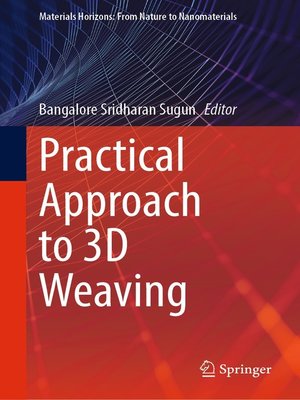Practical Approach to 3D Weaving
ebook ∣ Materials Horizons: From Nature to Nanomaterials
By Bangalore Sridharan Sugun

Sign up to save your library
With an OverDrive account, you can save your favorite libraries for at-a-glance information about availability. Find out more about OverDrive accounts.
Find this title in Libby, the library reading app by OverDrive.



Search for a digital library with this title
Title found at these libraries:
| Library Name | Distance |
|---|---|
| Loading... |
Three Dimensional Weaving is a nascent technology which has triggered research interests around the world. The technology has the potential to finely balance the in-plane and out-of plane properties in composites. This state-of-the-art book focuses on three emerging 3D weaving technologies viz., Orthogonal weaving, Angle interlock weaving and Dual Plane shedding based 3D weaving. It provides focused knowledge about these technologies and has a pragmatic approach to developing customized 3D weaving machines. Fundamental approach to understanding weave design basics, thereupon practical weaving , addressing quality aspects, arriving at testing approaches are all detailed in the book. The applications for these technologies are both in strategic (space, aerospace, defense) as well as societal (medical, automobile) sectors.
The book has six chapters, wherein the first three chapters are devoted to Orthogonal and angle interlock weaving and their quality control aspects. Approach to weaving preforms of complex geometries such as T-stiffeners, tapers, Origami-based structures are also discussed The fourth and fifth chapter are entirely devoted to machinery development for Dual plane shedding based 3D weaving often termed as 'True 3D weaving'. The chapters discuss detailed machine design of the sub-elements such as let-off, shedding, picking, beat-up and take-up. The reader is taken through a prototype development of a 3D weaving machine by way of concept, illustrations, practical development and weaving of samples. The sixth chapter summarises the editor's views about the technology. This volume will be beneficial to scientists and researchers in both academia and the industry.







